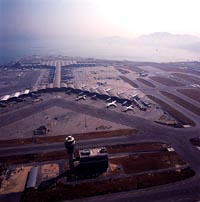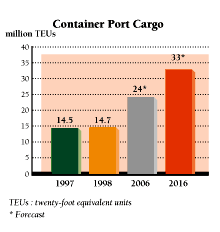|
Infrastructure Development
Despite the economic downturn, a long record of fiscal prudence has allowed
the government to press ahead with a new phase of infrastructure development which
will greatly improve access to urban areas and the northwest New Territories, open
up new land for development and improve the quality of life in Hong Kong.
The projects will boost Hong Kong's position as a regional transport hub and provide
tens of thousands of jobs.
The five-year, HK$235 billion (US$30 billion) commitment will cost 50% more than
the 10 Airport Core Projects, which took seven years to complete.
The projects will include:
- More than 60km of new railways, which will improve access to the northeast and
northwest of Hong Kong, facilitate further development of these regions and improve
access to the Mainland
- Construction of, and improvements to, more than 100km of strategic roads over
the next decade to alleviate urban congestion and improve access to existing and
new road crossings into the Mainland
- More than 600 hectares of new land for residential development, schools, open
space, commercial use, transport facilities and a science park
- A HK$8 billion (US$1.02 billion) sewage disposal scheme to greatly improve water
quality
New Airport
Hong Kong International Airport at Chek Lap Kok is among the 10 most remarkable construction
projects of the 20th Century. - Conexpo-CON/AGG '99 construction achievement awards
of the century, March 1999. Hong Kong's airport was the only Asian 'achiever' in
a list that included the Panama Canal, the Channel Tunnel, Egypt's Aswan High Dam,
New York's World Trade Centre and Empire State Building, the Sydney Opera House,
the Golden Gate Bridge, the Hoover Dam in Arizona and the US Defence and Interstate
Highway Network
Hong Kong International Airport was voted the best in the world in 1998 by an independent
panel of high-profile international travellers. -1998 Critics' Choice of Best Airport,
US Travel and Leisure magazine, January 1999
Hong Kong International Airport has the best media communications of any airport
in Asia. -Journalists' Choice Award, OAG Worldwide, January 1999
The new Hong Kong International Airport opened to air traffic on July 6, 1998, after
an overnight move from the old airport at Kai Tak in one of the world's biggest peace-time
logistical operations.
The new airport - on a largely man-made 1 248-hectare island off the north coast
of Lantau Island - has since established a reputation as one of the world's most
modern and efficient. Its design and facilities have won accolades from tourism industry
writers and engineers.
The airport site is about the same size as London's Heathrow and is the only one
in the world to have every frontal gate capable of taking a 747 aircraft or larger.
Baggage reclaim, Immigration and Customs clearance times are all faster than at Kai
Tak. There are fewer departure and arrival delays. There is a much greater choice
of retail and catering outlets. It is far more spacious and comfortable. It is easily
accessed on a new integrated transport network of roads and railway lines serving
the urban areas and beyond.
The airport's second runway opened to scheduled services on May 26, 1999. This allows
greater flexibility in airline scheduling around peak arrival and departure times
and increases the flight capacity of the airport. Full service of the runway is expected
in August 1999.
Since its opening, the airport has set a number of Hong Kong records in terms of
passenger throughput, baggage handling efficiency and flight movements:
- A new daily record of 117 000 passengers and their baggage was set on February
21, 1999, during the peak Lunar New Year period. The previous passenger record of
100 000 passengers in a day - set on December 27, 1998 - was surpassed on February
13, 14, 19 and 20.
- Record baggage handling efficiency was set on February 13, when 96 000 bags were
handled compared to the normal daily throughput of 60-70 000. Only 25 bags were 'short-shipped'
or missed the scheduled flight.
- The highest number of flights on a single day was 560, set during the Easter
holidays on April 2, when an additional 123 flights were scheduled.
The airport opening was initially marred by technical and teething problems in the
passenger terminal, which affected baggage handling, flight information displays,
lifts and escalators and even the public toilets. These were largely rectified within
a fortnight of opening.
Air cargo handling was more seriously affected by problems with the automated handling
system at the new 'Super Terminal 1' operated by Hong Kong Air Cargo Terminals Ltd
(HACTL). This forced HACTL to re-open its air cargo facility at Kai Tak until the
new terminal at Chek Lap Kok - one of the world's biggest - was running smoothly.
By August 24, all incoming and outgoing air cargo was being handled at HACTL's new
Super Terminal 1.
The initial problems created widespread public criticism, which in turn led to three
separate enquiries being held:
- A government-initiated, independent Commission of Inquiry headed by a High Court
Judge
- An investigation by a Legislative Council Select Committee
- An investigation by the Ombudsman
All three reports were released within the first quarter of 1999 and, in varying
degrees, highlighted areas where communication and co-ordination between the government
and the Airport Authority, and within the Airport Authority itself, should have been
better. The government has taken the criticisms on board and will bear them in mind
if a similarly large undertaking is attempted again in Hong Kong.
The new airport has an initial capacity of 35 million passengers and 3 million tonnes
of cargo a year. On full development, it will be able to handle about 90 million
passengers and 9 million tonnes of cargo a year.
Port
Hong Kong has one of the world's busiest and most efficient container ports. It is
privately owned and operated.
Container throughput in 1998 rose slightly over 1997 - 14.7 million twenty-foot equivalent
units (TEUs) compared to 14.5 million in 1997. This made Hong Kong the second-busiest
container port in the world in 1998 after Singapore. Hong Kong had held the top position
from 1992-97.
A new Container Terminal No 9 (CT9) is under construction to meet expected demand
in the early years of the next century. The first berth of CT9 is currently due to
come into operation in 2002. Upon completion, CT9 will increase Hong Kong's container
terminal capacity by more than 2.6 million TEUs per year. Future terminals are planned
for the early years of the next century.
The first purpose-built River Trade Terminal at Tuen Mun began operations in October
1998 and will be fully developed by late-1999. New mid-stream depots at Stonecutters
Island also opened in 1998.
There are proposals for a second river trade terminal at Lantau Island, deep waterfront
industries at Tseung Kwan O and Tuen Mun, and mid-stream sites at Tsing Yi and Lantau.
 |
Last updated: June 1999 |
|




 |

